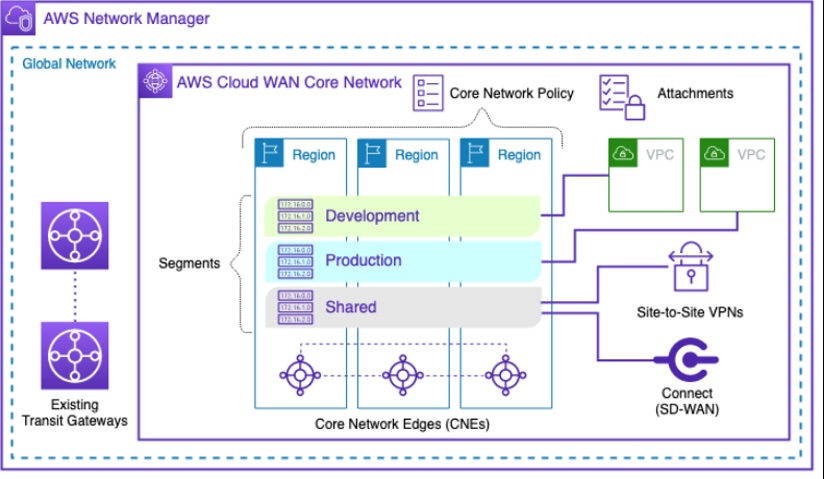Harnessing the Power of AWS Cloud WAN: Advantages Over Transit Gateway

Table of Contents
Introduction
In the ever-evolving world of cloud networking, businesses are constantly seeking ways to build scalable, secure, and easily manageable global networks. AWS Cloud WAN has emerged as a compelling solution, offering advanced features that go beyond what AWS Transit Gateway provides. This post explores how Cloud WAN simplifies global connectivity, enhances automation, and streamlines network segmentation compared to traditional Transit Gateway solutions.
Understanding AWS Transit Gateway
AWS Transit Gateway acts as a centralized hub for connecting Amazon VPCs and on-premises networks—primarily within a single AWS Region. It offers the following advantages:
- Regional Connectivity: Ideal for interconnecting VPCs in one region.
- Hub-and-Spoke Model: Simplifies connections between multiple networks.
- Manual Configuration: Requires setting up peering connections and static routes for cross-region traffic.
While effective, managing complex routing, segmentation, and cross-region connectivity with Transit Gateway often involves manual intervention and can lead to higher operational overhead.
What is AWS Cloud WAN?
AWS Cloud WAN is a managed wide area network (WAN) service that unifies your data center, branch, and AWS networks across multiple Regions. Cloud WAN leverages a central core network policy to automatically configure and manage the network infrastructure.
Key features include:
- Global Network Management: A single dashboard via AWS Network Manager provides a centralized view of your entire network.
- Dynamic Routing & Segmentation: Automated route propagation using BGP, with native support for multiple routing domains (segments).
- Declarative Network Policies: Define your network intent through a core network policy, and let AWS handle the configuration details.
- Enhanced Visibility: Integrated performance monitoring with granular CloudWatch metrics improves troubleshooting and optimization.
Benefits of AWS Cloud WAN Over Transit Gateway
1. Global Reach and Simplified Cross-Region Connectivity
Unlike Transit Gateway, which is limited to a regional scope, Cloud WAN unifies connectivity across all AWS Regions. This global management simplifies complex inter-region peering and removes the need for manual configuration, enabling seamless communication between geographically dispersed resources.
2. Automated Network Management
With Cloud WAN, network configuration is defined by a declarative core network policy. This means you can automate route propagation and segmentation without manually updating route tables, reducing the risk of misconfigurations and lowering operational overhead.
3. Enhanced Traffic Segmentation
Cloud WAN’s segmentation capabilities allow you to create isolated routing domains—similar to VRFs in traditional MPLS networks. This makes it easier to segregate traffic (e.g., production, development, staging) and apply consistent security policies across your network.
4. Dynamic Routing and Policy-Based Automation
Cloud WAN supports dynamic routing via BGP, which automatically adapts to changes in your network. Combined with policy-based automation, it ensures your network remains resilient and scalable as you add new regions or on-premises connections.
5. Simplified Operational Model and Enhanced Visibility
AWS Network Manager centralizes network monitoring, offering dashboards, topological maps, and detailed performance metrics. This unified view simplifies troubleshooting, allowing you to quickly identify and resolve issues across your global network.
Real-World Use Cases
AWS Cloud WAN is particularly beneficial for:
- Global Enterprises: Seamlessly connecting data centers and branch offices across continents.
- Hybrid Architectures: Integrating on-premises environments with cloud resources through automated and resilient connectivity.
- Dynamic Scaling: Quickly adapting network infrastructure as your business grows, without extensive manual reconfiguration.
Best Practices
- Define Clear Segmentation Policies: Use Cloud WAN’s segmentation features to create isolated network domains that align with your business units.
- Automate with Infrastructure as Code: Manage your core network policy using declarative configurations and automation tools to minimize human error.
- Monitor and Optimize: Leverage CloudWatch and AWS Network Manager dashboards to continuously monitor network performance and adjust configurations as necessary.
- Plan for Hybrid Connectivity: Ensure that your on-premises networks are properly integrated with Cloud WAN to take full advantage of dynamic routing and segmentation.
Conclusion
AWS Cloud WAN offers a transformative approach to building and managing global networks. Its ability to simplify cross-region connectivity, automate network management, and enhance traffic segmentation makes it a powerful alternative to traditional Transit Gateway solutions. By adopting Cloud WAN, organizations can achieve a more agile, resilient, and cost-effective network infrastructure, paving the way for seamless digital transformation.
Further Resources
- AWS Cloud WAN Documentation
- AWS Transit Gateway Documentation
- AWS Network Manager
- AWS Networking & Content Delivery Blog
Happy networking!